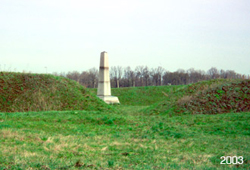|
 The term "redoubt" is possibly derived from the French word “redoubt”,
which means "shelter." In Britannic military terminology it was used for isolated defensive
installations that were equipped with all necessities to withstand a long siege. As an
an artificial obstacle,
a redoubt was a closed fortification shaped in the form of
a regular or irregular polygon strengthened by a barrage. Each of
the redoubts functioned independently as a separate defense installation.
Redoubts appeared in the fifteenth century and were used as a main form
of defensive installation until World War I (1914 - 1918).
The term "redoubt" is possibly derived from the French word “redoubt”,
which means "shelter." In Britannic military terminology it was used for isolated defensive
installations that were equipped with all necessities to withstand a long siege. As an
an artificial obstacle,
a redoubt was a closed fortification shaped in the form of
a regular or irregular polygon strengthened by a barrage. Each of
the redoubts functioned independently as a separate defense installation.
Redoubts appeared in the fifteenth century and were used as a main form
of defensive installation until World War I (1914 - 1918).
The Russian Tsar Peter I used redoubts on the
Poltava battlefield as a support for his frontline troops.
To cover the approach to the fortified camp of the Russian army
and disrupt the battle formation of the
advancing enemy, Tsar Peter I ordered two lines of square or
rectangular redoubts built in the form of the letter T.
Each redoubt consisted of earthwork with
a rampart and a deep trench, and was protected by a palisade.
The Belgorod regiment, under the command of Brigadier Aigustov, provided most of the
garrisons deployed in the redoubts. The artillery of the
redoubts consisted of 16 guns. The Russian cavalry
under the command of Menshikov was positioned
behind the line of redoubts.
While preparing for the
bicentenary celebration of the Battle of Poltava ten concrete obelisks were erected in the places where
the redoubts were believed to have been located.
Although the obelisks were originally crowned with double-headed bronze eagles,
these were removed soon after the Revolution of 1917. In 1939 the obelisks were
replaced with 4.5 meter high granite pyramidal obelisks.
Two of the redoubts were reconstructed in their original form in 1953 and 2009.
|
 History
History
 Dates and events
Dates and events
 Persons
Persons
 Poltava
Poltava
 Sights
Sights
 Photo gallery
Photo gallery
 Maps
Maps
 Virtual Museum
Virtual Museum
 Armament
Armament
 Uniforms
Uniforms
 Coins and medals
Coins and medals
 Flags
Flags
 Paintings
Paintings
 Poltava photographs
Poltava photographs
 News
News
 About us
About us
 Acknowledgments
Acknowledgments
 Main page
Main page
 Photo gallery
Photo gallery
 top
top ...back
...back  The term "redoubt" is possibly derived from the French word “redoubt”,
which means "shelter." In Britannic military terminology it was used for isolated defensive
installations that were equipped with all necessities to withstand a long siege. As an
an artificial obstacle,
a redoubt was a closed fortification shaped in the form of
a regular or irregular polygon strengthened by a barrage. Each of
the redoubts functioned independently as a separate defense installation.
Redoubts appeared in the fifteenth century and were used as a main form
of defensive installation until World War I (1914 - 1918).
The term "redoubt" is possibly derived from the French word “redoubt”,
which means "shelter." In Britannic military terminology it was used for isolated defensive
installations that were equipped with all necessities to withstand a long siege. As an
an artificial obstacle,
a redoubt was a closed fortification shaped in the form of
a regular or irregular polygon strengthened by a barrage. Each of
the redoubts functioned independently as a separate defense installation.
Redoubts appeared in the fifteenth century and were used as a main form
of defensive installation until World War I (1914 - 1918).